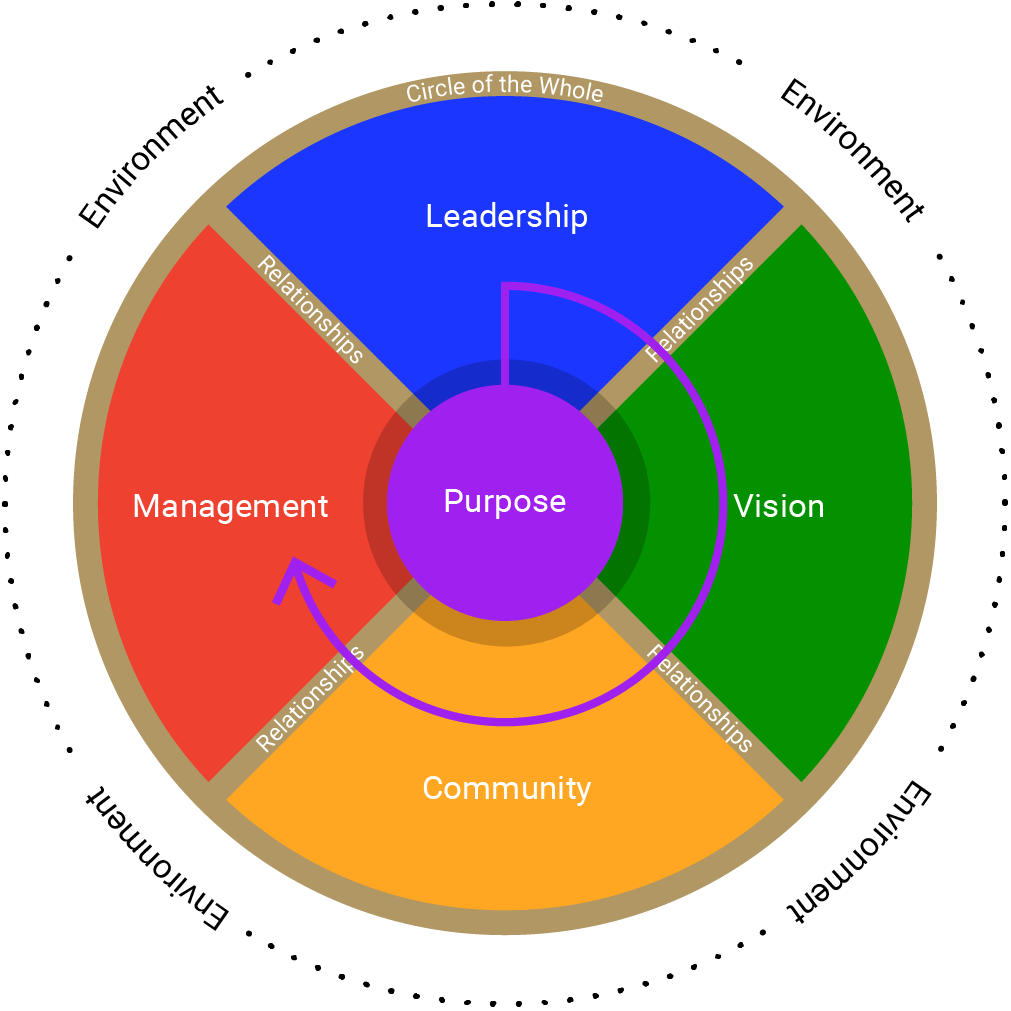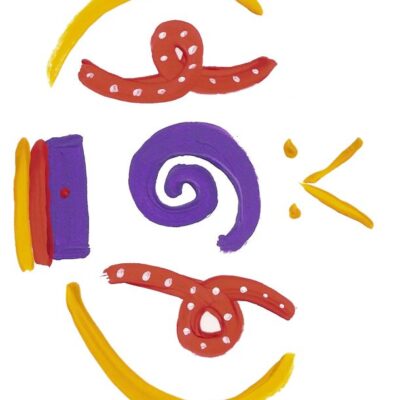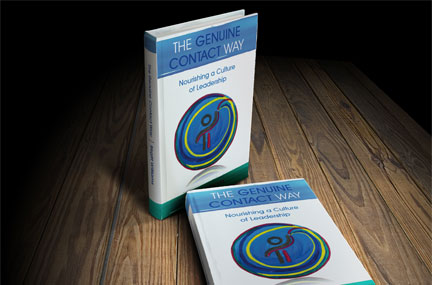
The beauty of this simple tool is that by learning one tool, it will work for you in so many team, organization, community, family and leadership situations. Keeping it simple is one of our guiding beliefs. This goes right along with ‘if we use a simple to understand tool, we can handle complexity…the more complex the tools, the less effective they are in handling complexity’. Birgitt Williams and I (Rachel) are currently offering a workshop focused on working with a multi-purpose tool that functions as a navigational compass for leadership and organizational development. As a multi-purpose tool it functions as a framework for coaching, problem clarification, generation of solutions, project development, project turn around and so much more.
Birgitt Williams chose to call this tool the Medicine Wheel Tool. We wanted to tell you a little of the story of why it is called the Medicine Wheel Tool, not the navigational compass or the organizational compass.
Mandala Work
Mandalas, basically a circle that is filled in with something usually representational of a teaching or a journey, show up as an archetypal shape in nearly every ancient culture – Indigenous Peoples in the Americas and Australia, Celts, Norse, African, etc. Drawing a circle is a first step in separating what is inside the circle from the vastness of our vast world, useful in helping to make sense of the aspect of our world that we want to consider. These mandalas have different names depending on the history, but each is said to be rooted in the same teachings and energy.
One common example of a mandala is the Yin/Yang symbol from the far east, now recognized universally with different meanings associated to the teaching, to the journey work in using this mandala.
Another common example of a universal archetype of a mandala is a circle with lines intersecting in the middle. This may represent the rising and setting of the sun and the intersection with the earth. In her travels around the world, Birgitt has looked for this symbol in pre-historic art including cave art…and found it. Birgitt had a particular interest in this mandala as she had been taught how to work with this mandala beginning in the 1970’s when she was working on the Six Nations of the Grand River Territory and fell in love with what the Indigenous Peoples in North America refer to as the Medicine Wheel. Birgitt has deep respect for the Medicine Wheel, a powerful tool for examining relationships and finding personal and community direction.
>> Read more about the this learning
In other parts of the world, working with this mandala of the circle intersected by two lines has different names, and attributed with different meanings. Regardless of the names given to the mandala, it is a universal archetype that helps people make sense of their world. Because it is a universal archetype, each of us has this archetype within our genetic memory and our ancestral history in some way. It is the power of this universal genetic memory that, in part, makes working with this mandala, the Medicine Wheel, so powerful.
When we look at the Medicine Wheel in the North American context, it is a sacred teaching. Like many sacred teachings, languages, arts, and spiritual practices, the Medicine Wheel was largely hidden and kept safe by knowledge keepers who were charged with holding this valuable knowledge safe and intact during the many years of colonialism, residential schools, and other trauma that attempted to quash Indigenous cultures.
In 1987, a group of Indigenous Elders came together in the American Southwest and said that the time of the legends had come. That it was time for these sacred teachings to not only emerge from hiding but to be spread across the world for the healing of all humanity, for the human race to find our way back to wholeness. 30 years later, the Medicine Wheel with its familiar colors of white, yellow, red and black is a more familiar sight. These colors associated quickly with Indigenous peoples and their artwork.
The Medicine Wheel Tool
The Medicine Wheel Tool was developed and is used within the Genuine Contact Way of working. The Medicine Wheel Tool is rooted in these ancient traditions and provides an opportunity for working within a holistic framework in a variety of applications in both business and life. It does not attempt to be a sacred Medicine Wheel. It does have its roots in the teachings of this universal archetype and we use the name to pay respect to these roots.
When Birgitt created the Medicine Wheel Tool, she intentionally chose to not use the colors used by any Indigenous Peoples. In part, this was about not appropriating the Medicine Wheel for our work. Birgitt, guided by her intuition, intentionally chose colors of the rainbow to represent diversity, universality, and inclusion.
In naming the tool, Birgitt carefully chose to call it the Medicine Wheel Tool. Birgitt felt so much respect for the universal archetype, the extensive human history of working with mandalas, and particularly the Indigenous Medicine Wheel teachings. Her business coaches wanted her to take this knowledge rooted in the Medicine Wheel and repackage and repurpose it under the name Organizational Compass – a name that would have perhaps had more business appeal – but Birgitt felt it was important to honor the Medicine Wheel in which this tool is rooted. She faced the question of how to honor the Medicine Wheel while not engaging in cultural appropriation. It was during this decision that she went to an elder on the Six Nations of the Grand River Reserve and he gifted Birgitt an audiotape Moh-he-con-nuck: Medicine Wheel Teachings. It provided Medicine Wheel wisdom for the human race to use.
Since that time 25 years ago, the Medicine Wheel Tool has been used in groups around the world, including participation with Indigenous people from many cultures. This gift of wisdom has been confirmed repeatedly, including a note from a workshop participant in 2019, who wrote after a program: “Two years ago, I had the great honor of hosting Indigenous Elder Don Coyhis and the Hoop with 101 Eagle feathers at a national conference. Don confirmed the gift of the hoop (Medicine Wheel) and its wisdom to all people of the world in a moving ceremony at the start of the event.”
The idea of appropriation is something that is often in the spotlight these days, and for good reason. As a simple definition, cultural appropriation is when a dominant group uses the art, cultural or religious symbols, ideas and expressions from long-marginalized groups for its own benefit or enrichment. This happens all too often and is worth paying attention to.
In the lead up to this workshop, the question of cultural appropriation was raised. Not as an accusation. Merely a question. Had we considered the idea of cultural appropriation in working with the Medicine Wheel Tool?
We have talked about it in the workshop and wanted to also share some of this conversation here, with you.
In developing the Medicine Wheel Tool, in using it in our work and in teaching it to others, we believe that it is important to pay homage to the long standing history of the Medicine Wheel as it appears in all ancient peoples. We talk about how the Medicine Wheel Tool is rooted in these ancient traditions, and that they are important traditions that are rooted in the genetic memory of all humanity. We also make clear that the Medicine Wheel Tool is named this way to honor the roots…and simultaneously it is not the Medicine Wheel of the Native Peoples of North America.











Erin
I was introduced to this tool last week in a university course on group facilitation and I am acutely uncomfortable with the name of this tool. I don’t understand why you felt that using the traditional colours of the Medicine Wheel would have been appropriative, but using the name is not. Taking something with a long, sacred history and repackaging it to suit your own purposes is appropriation. When you make a profit from your appropriation it is exponentially more egregious. One elder cannot give you permission to use the Medicine Wheel – it isn’t solely his to give. This is unacceptable in 2019 and I urge you to rename your wheel.
Rachel Bolton
Thanks for your thoughtful and concerned note about the name of the tool. We also are aware of the critical importance of appropriation. Mandalas similar to this exist in every traditional culture and whether the name was a circle, hoop, or wheel it would be connected to one of those cultural roots. We absolutely agree with you that one person giving permission on behalf of many cultural traditions would be inappropriate. Throughout 25+ years of working with this tool internationally, we’ve heard many stories of both appreciation for what has been developed and affirmation that there is permission from many Elders from geographically diverse Indigenous groups to share these teachings with others. Would you be open to having a conversation about your concerns? Birgitt Williams, who named this tool, would be interested in your thoughts.
Erin
“Mandalas similar to this exist in every traditional culture and whether the name was a circle, hoop, or wheel it would be connected to one of those cultural roots.” I suppose any and all circles are connected on some level based on their shape, but it needn’t to go beyond that. A tool can be very useful, transformative even, without adopting a name that is culturally-bound to a people and a tradition that has been exploited for hundreds of years. Current thinking on cultural appropriation has changed a lot in 25 years. I believe what may have been acceptable when this tool was first designed and what is acceptable now has changed.
Rachel Bolton
Thanks Erin. For people like Birgitt, who spent a great deal of time with indigenous peoples, the topic of appropriation was as important many years ago as it is now. In Birgitt’s research and universal perspective, using a circle and emphasizing four cardinal directions including the associated archetypes required that in her integrity, she must give acknowledgment that this is based on the universal teachings of indigenous peoples, particularly the native peoples with whom she worked so closely in Ontario, Canada. To omit this link of the lineage from which this wisdom is rooted would have been a serious omission. Therefore, we use a name that does its best to acknowledge all of that and discuss these origins whenever we teach about the tool.
Erin
I respect your willingness to dialogue about this issue! Some moderators may have chosen not to publish my comments. For now, we’ll have to agree to disagree.